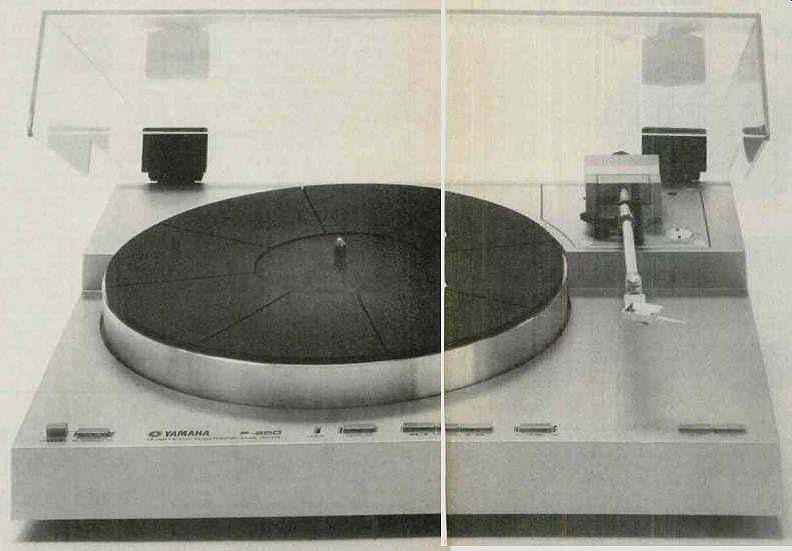
Manufacturer's Specifications:
Motor: Direct-drive, quartz-lock PLL.
Speeds: 33 1/3 and 45 rpm.
Wow & Flutter: 0.015% wtd. rms.
Rumble: Better than -77 dB (DIN-B).
Arm: Static balanced, sliding weight.
Anti-Skating: Spring type.
Suitable Cartridge Weight: 2.5 to 10 g.
Cable Capacitance: 100 pF.
Dimensions: 17 3/8 in (44.1 cm) W x 14 3/4 in. (37.5 cm) D x 5 1/8 in. (13.0 cm) H.
Weight: 16 1/2 lbs. (7.5 kg).
Price: $360.00.
Yamaha's new P-850 is a typical example of modern turntable design, with its sleek, low-profile styling and impeccable performance. It uses a direct-drive servo-controlled motor, while its arm is controlled by two separate motors. The arm itself is a straight tubular type, mounted on a platform at the rear, which extends the full width of the unit. A neat rectangular counterweight slides on two runners and is adjusted by a small knob. The actual tracking force is set by a sliding weight in front of the pivot. The arm is calibrated from 0 to 3 grams in 0.1-gram steps, on a scale which extends almost up to the carbon-fiber resin headshell.
The shell is secured to the arm by a set-screw, eliminating one potential source of trouble. Length of the arm is 8 3/4 inches (222 mm) and effective mass is stated as a low 11 grams (without the cartridge). The spring-type anti-skating control is located in front of the arm base, to the right of the arm rest.
The operating controls are in the form of nine pushbuttons lined up at the front. From left to right they are: "Power" (On-Off). "Speed," 'Repeat " arm movement left, vertical and right, record "Size," "Cut," and "Play." Indication for record size (12 and 7 in.) and the first three functions is given by tiny illuminated "windows" at the side of the pushbuttons.
The drive motor is a d.c. brushless, coreless eight-pole type, and the aluminum diecast platter weighs 3 1/2 lbs. It is unusually deep, with the top of its highly polished edge about an inch above the base and its mat extending nearly 1/4 inch above that. I noted with approval that this mat is of rubber with no ribs or projections that could form cavities.
The base is made from a Bulk Molding Compound finished in a satin silver.
Measurements
For test purposes, Shure V-15 Type V was mounted in the shell (which has a very low mass), and both tracking force and anti-skating adjustments were set to 1.25 grams, making due allowance for the Shure stabilizer "brush." Arm resonance was measured at 9 Hz with a broad rise of less than 2 dB. The cartridge was aligned with the Shure two point gauge (supplied with the cartridge), and checked with the Dennesen protractor; it was found to be right on the nose. The actual error figures were -1, +2 degrees, a little better than claimed. So full marks to Shure for an easy-to-use device which enables even the most ham-handed to achieve remarkable accuracy.
Wow and flutter measured 0.025% (DIN 45-507) while rumble was 63 dB, using the ARRL weighting. By employing the Thorens Rumpelmesskoppler (which allows measurements to be made via the center spindle), the figure increased to 70 dB. Both vertical and lateral arm bearing friction were extremely low, with no sign of irregularities. The tracking force calibration was found to be within 5% down to 1 gram. Speed was less than 0.1% fast.
The unit is fully automatic: after the "Play" button is depressed, the arm moves to its correct position and the motor is switched on. Before the stylus is actually in the lead-in groove, a speed lock indicator, positioned next to the "Repeat" switch, lights up. At the end of play, the arm returns to its rest, taking about five seconds. The three cue buttons give complete control over the arm via the two independent motors. If the left or right button is only slightly depressed, the arm will move slowly; but pressing harder will increase the speed. If one of these two buttons is depressed while a record is being played, the arm will rise, just as if the center Up-Down button were used.
Because there are so many conflicting requirements, there is no "right" way to deal with the problem of acoustic feedback and Yamaha has elected to mount the arm and motor to the base to provide "mass" instead of isolation.
The unit is mounted on four resilient feet, and tests showed that it was not particularly susceptible to airborne or vibrational feedback.
Although the P-850 does not boast a variable speed control, digital readout or other eye-catching features, it does offer fine basic performance. It certainly deserves a top-flight phono cartridge, preferably a high-compliance type to match its remarkably low-mass arm.
-George W. Tillett
(Source: Audio magazine, Sept. 1982)
Also see:
Yamaha YP-701 Automatic Turntable (June 1975)
Fulton Moving-Coil Transformer/Cartridge (Sept. 1982)
= = = =